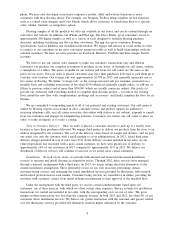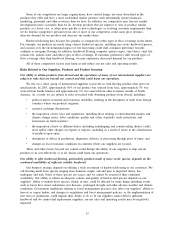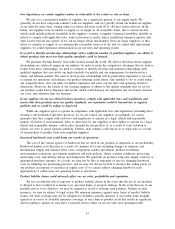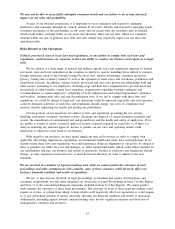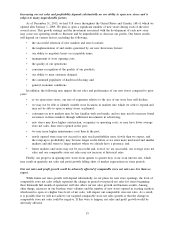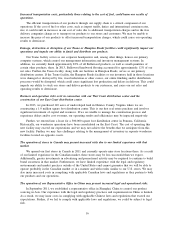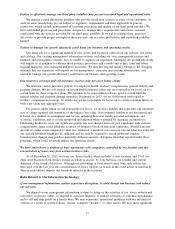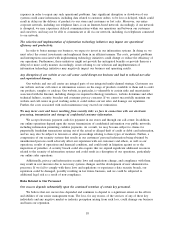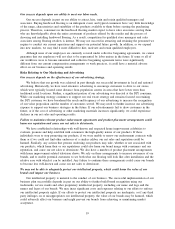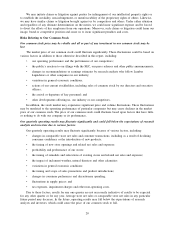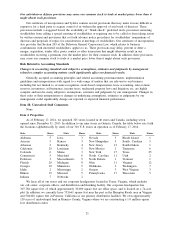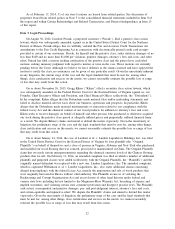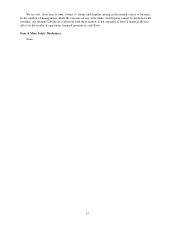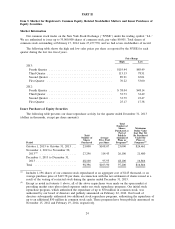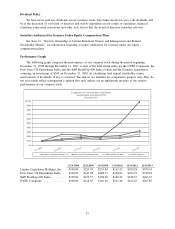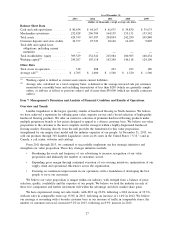Lumber Liquidators 2013 Annual Report Download - page 27
Download and view the complete annual report
Please find page 27 of the 2013 Lumber Liquidators annual report below. You can navigate through the pages in the report by either clicking on the pages listed below, or by using the keyword search tool below to find specific information within the annual report.Failure to effectively manage our third party installers may present increased legal and operational risks.
We manage certain third party installers who provide installation services to some of our customers. As
such, in some jurisdictions, we are subject to regulatory requirements and risks applicable to general
contractors, which include management of licensing, permitting and quality of our third party installers. We
have established processes and procedures designed to manage these requirements and ensure customer
satisfaction with the services provided by our third party installers. If we fail to manage these processes
effectively or provide proper oversight of these services, our net sales, profitability and reputation could be
harmed.
Failure to manage our growth effectively could harm our business and operating results.
Our plans call for a significant number of new stores, and increased orders from our website, call center
and catalogs. Our existing management information systems, including our store management systems and
financial and management controls, may be unable to support our expansion. Managing our growth effectively
will require us to continue to enhance these systems, procedures and controls and to hire, train and retain
regional managers, store managers and store associates. We may not respond quickly enough to the changing
demands that our expansion will impose on our management, associates and existing infrastructure. Any
failure to manage our growth effectively could harm our business and operating results.
Our insurance coverage and self-insurance reserves may not cover future claims.
We maintain various insurance policies for employee health, workers’ compensation, general liability and
property damage. We are self-insured on certain health insurance plans and are responsible for losses up to a
certain limit for these respective plans. We continue to be responsible for losses up to a certain limit for
general liability and property damage insurance. Beginning in 2013, we are self-insured with regard to
workers’ compensation coverage, in which case we are responsible for losses up to certain retention limits on
both a per-claim and aggregate basis.
For policies under which we are responsible for losses, we record a liability that represents our estimated
cost of claims incurred and unpaid as of the balance sheet date. Our estimated liability is not discounted and
is based on a number of assumptions and factors, including historical trends, actuarial assumptions and
economic conditions, and is closely monitored and adjusted when warranted by changing circumstances.
Fluctuating healthcare costs, our significant growth rate and changes from our past experience with workers’
compensation claims could affect the accuracy of estimates based on historical experience. Should a greater
amount of claims occur compared to what was estimated or medical costs increase beyond what was expected,
our accrued liabilities might not be sufficient and we may be required to record additional expense.
Unanticipated changes may produce materially different amounts of expense than that reported under these
programs, which could adversely impact our operating results.
We have entered into a number of lease agreements with companies controlled by our founder and this
concentration of leases may pose certain business risks.
As of December 31, 2013, we lease our Toano facility, which includes a store location, and 29 of our
other store locations from entities owned, in whole or in part, by Tom Sullivan, our founder and current
chairman of our board of directors. Although our percentage of total stores leased from such entities has
decreased over the last year, this concentration of leases subjects us to risk in the event action or inaction by
Tom or such entities impacts our leasehold interests in the locations.
Risks Related to Our Information Technology
If our management information systems experience disruptions, it could disrupt our business and reduce
our net sales.
We depend on our management information systems to integrate the activities of our stores, website and
call center, to process orders, to respond to customer inquiries, to manage inventory, to purchase merchandise
and to sell and ship goods on a timely basis. We may experience operational problems with our information
systems as a result of system failures, viruses, computer ‘‘hackers’’ or other causes. We may incur significant
17



